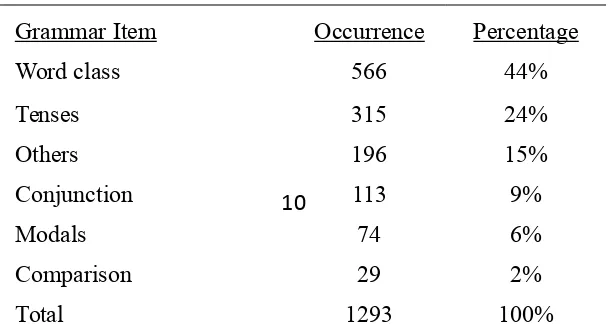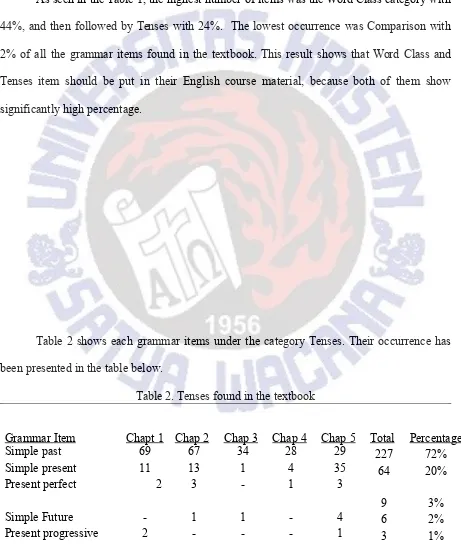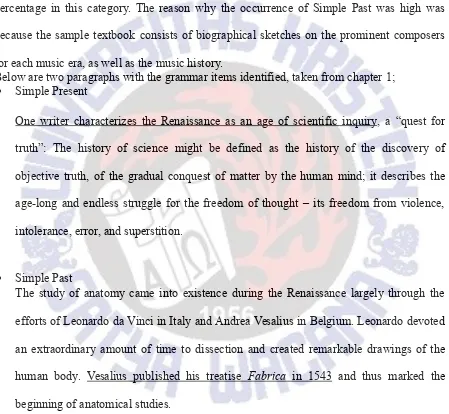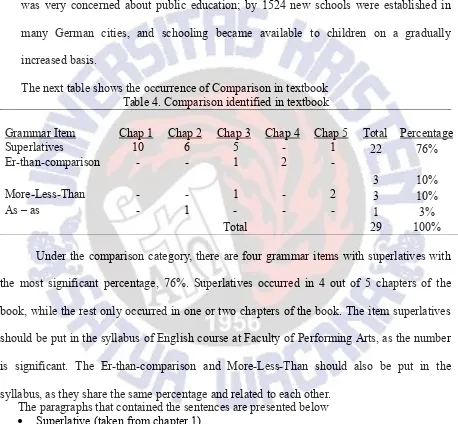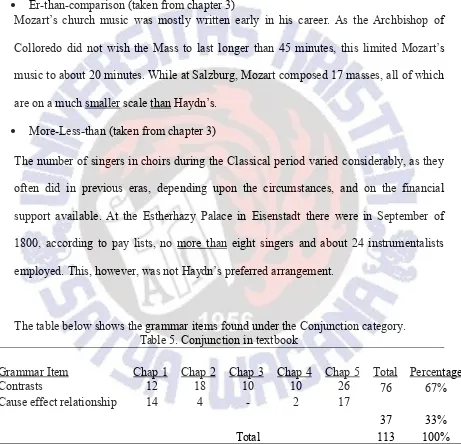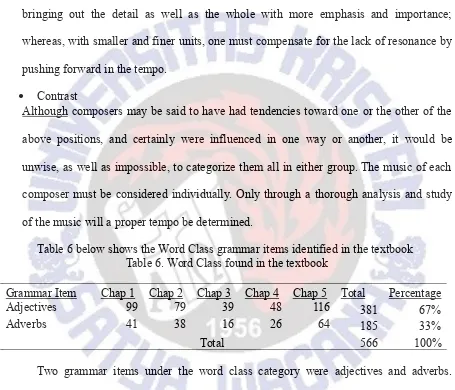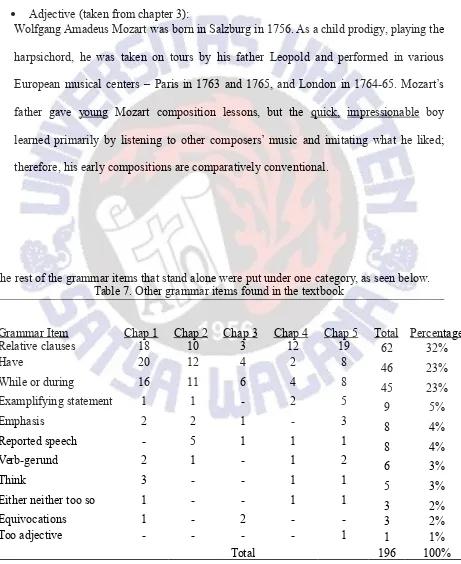Needs Analysis on Grammatical Aspects in Textbooks for Students of
Performing Arts
Maria Lusia Anindya Larasati
Satya Wacana Christian University, Indonesia
Abstract
This study was conducted to identify needs analysis on grammatical aspects in textbook for students of performing arts in Satya Wacana Christian University. In this study the textbook sample was taken from the Church Music Literature class. There was only one tool used in the study, Lesson Writer. The data of this study were collected by inputting the sample text to the tool mentioned. From the result of Lesson Writer there were 39 grammar items identified in the textbook. After being categorized, the result of this analysis indicated that Tenses and Word Class were the items appeared the most in the textbook. They became the need of the students at Faculty of Performing Arts as they need to understand the course books. Based on the result, there was a suggestion to put Tenses and Word Class in their English course syllabus.
Keywords: needs, needs analysis, ESP, grammar items
Introduction
According to Abdullah (2009, p. 1) ESP needed to be included in the academic curricula of most universities and colleges of higher education to help their ESL/EFL students come to grips with materials written in English. The expectation is, with tailored ESP lesson they can maximize the use of English in the specific fields.
Through ESP, it is expected that the students will be able to achieve a satisfactory level in mastering English. Widdowson (1987) pointed out that with ESP, the language course can be more precise in specifying what language the learner will have to cope with. Needs analysis should be conducted first in order to know the exact needs of the students. Later, the result of the needs analysis will be the base to determine which materials and curriculum will be used in class. Without needs analysis, it will be difficult to develop a lesson, as the needs of students from different fields will have a different needs too. Through a clear needs analysis, it would help both the students and the teacher to make the best effort in bringing English on their specific fields.
The Faculty of Performing Arts, Satya Wacana Christian University, has English course in their courses flow chart. This means that all students must take the English course provided by the faculty. They are using English textbooks for most of the courses. However, English course in the faculty is still having difficulty to determine which part should be prioritized in teaching. There is a need to conduct needs analysis to know whether the English course in the Faculty of Performing Arts had fulfilled the students’ needs or not. Hutchinson and Waters (1986, p. 8) asserted by analyzing linguistic characteristics in the specialist area learned by a particular group of learners, the English needs could be identified.
The problem investigated in this study was the unclear objective of English course in Faculty of Performing Arts. The students’ ability to master English were varied. For example, not all of them have mastered all form of tenses in English. Despite their insufficient English ability, they have to read English textbooks for almost all of their courses. Therefore,
grammar is taught in the current English course because of the students’ varied English skills. However, there are many grammar items that should be taught with a 4 credits English course. A thorough needs analysis needs to be conducted in order to identify what grammar aspects are needed by the students to support their learning.
Based on the discussion above, the question for this study was, what grammar aspects are needed by students of Faculty of Performing Art as identified in their textbook? The main purpose of this study was to identify what grammar aspects are needed by the FSP students in order to understand their required readings in English.
Knowing the exact needs of what grammar items are needed by the students could help the teacher to make a suitable syllabus. As mentioned before, there are only 4 credits available for English course, while the materials needed to be covered are many. For that reason, a needs analysis on the grammar aspects would help the teacher to determine which grammar items might be prioritized in the syllabus. Without conducting a needs analysis before designing a syllabus, the teacher tend to assume the needs of the students. Relying only on assumption will only lead into a misfit course.
Literature review
This section explains about needs analysis. This is an attempt to open insights related to needs analysis, for example what is needs analysis and how needs analysis is being used in ESP.
What is need?
The identification of needs depends on the judgment and the point of view of interests and values. In context of language, language needs are usually only seen as what kind of skills or knowledge needed by the learners to survive in an English speaking society, for example the needs of an immigrant to survive is different with the language needs of an international student. Robinson (1991) asserted that according to some experts such as Berwick, Brindley, Mountford, and Widdowson, needs can be categorized into four kinds of needs. The first one is needs as objectives, or goal-oriented. In this kind of needs, there is something that should be performed or done by the learners at the end of the course. The second is the learner’s institution or society think of what is necessary or desirable to be learnt. The third one is what the learners need to do to acquire the language, or refer as process-oriented definition of needs. The last one is the personal desires of the learners in the language being learnt.
Robinson (1991) then tried to define needs into objective and subjective needs, perceived and felt needs, and target versus learning needs. In perceived and felt needs, it contrasted the learners’ and teachers’ perception of needs. They might have different views of the goals at the end of the course. Subjective and objective needs may cover the same ground as perceived and felt needs. The target and learning needs are much alike with goal-oriented and process-oriented. In this study the need can be categorized under the first kind of needs, objective or goal-oriented. By knowing what the grammar items needed to be learnt by the students and put them in the syllabus, the goal is to
help students have a good understanding on English grammar and help them understand other courses better.
The importance of grammar
The English skill of each students entering Faculty of Performing Arts are varied as they have different academic background. Therefore, there is a need to make sure all the students are having the same basic in English skill, in this case is grammar. In learning a new language, the knowledge of grammar is a basic rule needed before stepping up to learn the skill of listening, speaking, reading, and writing. Thornbury (1999) gives several arguments on why it is important to put grammar as the ground for ESL teaching. He said that, “Grammar, after all, is a description of the regularities in a language, and knowledge of these regularities provides the learner with the means to generate a potentially enormous number of original sentences.” By knowing the grammar pattern, learners can use their creativity to create new sentences only based on the vocabulary they have. The second one is that by learning grammar, the learners can avoid ambiguity that might appear if they only stringing words and phrases together. Grammar also makes language digestible as it provides finite set of rules. As cited by Songhori, (2007), Dudley-Evans and St. John (1998) also suggest grammar as one of needs that were seen as discrete language items. In this case, the students hopefully are fluent in reading and able to understand their textbooks. Learning grammar can be dull to the students, but the different level of English mastery of students of Faculty of Performing Arts makes it important to review the grammar from the basic one.
unknown). Having a good understanding of grammar can help them in acquiring the language. Larsen-Freeman (1992) believes that grammar is the fifth skill after listening, speaking, reading, and writing.
Needs analysis in ESP
The idea of needs analysis in language teaching emerged as ESP was developing. At that time, the number of demand for specialized language program was high. Needs analysis was considered as an important part of tailoring language teaching programs in the 1960s (Johns, 2013). In order to dig more on the information that can be obtained to make a better program, needs analysis should conducted before starting a new program. .
From this point, it is clear why a thorough needs analysis is important to get the right information about the learners’ needs. The next question emerged is ‘what needs analysis actually is?’ According to Hyland (2006), needs analysis is a process, and also regarded as a technique to collect data from the learners;
Needs analysis refers to the techniques for collecting and assessing information relevant to course design: it is the means of establishing the how
and what of a course. It is a continuous process, since we modify our teaching as we come to learn more about our students, and in this way it actually shades into evaluation – the means of establishing the effectiveness of a course. Needs
is actually an umbrella term that embraces many aspects, incorporating learners’ goals and backgrounds, their language proficiencies, their reasons for taking the course, their teaching and their learning preferences, and the situations they will need to communicate in. Needs can involve what learners know, don’t know or
want to know, and can be collected and analysed in a variety of ways ( Ken Hyland, 2006, pg. 73)
In this study, what is considered as need is to know what grammar items the students may encounter the most in their textbooks. They need to have an effective English course. By knowing and learning the right grammar items, the students can master English grammar which can help them in understanding their textbooks.
Needs analysis is the first stage in developing a language teaching program especially in ESP. However, there were some needs analysis conducted during or after the course due to the short time of the program. Although time limitation is the challenge of having needs analysis, it is important not to omit it when planning a course. It is still important as needs analysis held some purposes. According to Richards (2001), needs analysis in language teaching has many different purposes, for example:
To find out what is the language skills needed by the learners
To determine whether the course has sufficiently fulfill the needs of learners To identify a change of direction that people in a reference group feel is important To identify a gap between their lacks and they wants
To gather information about particular problems faced by learners
The purpose of needs analysis in this study is to find out what is the language skill needed by the learners. In this study, the language skill is the grammar aspects. By knowing certain grammar aspects that are relevant to their study, the teacher can tailor a more suitable syllabus for the English course.
the resultant syllabus. The second one is Present Situation Analysis, which is conducted in the beginning of the course to examine the students’ strengths and weaknesses. Richterich and Chancerel (1994) suggest the three basic source of information: the students, the language-teaching establishment, and the ‘user-institution’.
The methods being use to collect data in needs analysis can be inductive or deductive procedures or both. While in inductive procedures they can rely on the experts’ intuitions, participant and non-participant observation, and unstructured interview, deductive procedures rely more on data taken from surveys, questionnaires, structured interviews, and criterion-reference performance tests. As cited by Flowerdew (2013), according to Long, from these methods, interview is known as the most widely use for needs analysis in ESP. Unstructured interview is appropriate to use when the interviewer has to rely on the respondent because of the limited insight of the matter. It can also be use for survey questionnaires or structured interviews follow-up. This study used the textbook they use in other courses to know what grammar items occurred. In other words, deductive procedure was used.
Significance of Needs Analysis
As the demand of ESP is increasing, the need to conduct a thorough need analysis is also increasing. Long (2005) stated that no language teaching program should be designed without a thorough needs analysis. He pointed out, “in foreign and second language teaching, one of several consequences is the increasing importance attached to careful studies of learner needs as a prerequisite for effective course design”. Preparing a course for students learning foreign or second language cannot be solely based on the assumption of the teacher only. Dakmouche (2008, p. 5) also supported this, “it is proposed that any ESP course should obey a strategy of
predetermined objectives based on a needs analysis which aim is to identify what students are requiring the foreign language for”. Every language course should be tailored based on the specific purposes of the students. Tailoring an ESP course without careful needs analysis will only lead into ineffective course.
The existence of needs analysis in ESP becomes important as needs analysis happens to be the foundation of designing a course, syllabus, or classroom activities (Astika, 2009). Designing one without needs analysis may lead to a misfit course and left the students’ needs unfulfilled. Needs analysis is a tool to design a course, and through the needs analysis, the specification of what language skills, functions and forms which is the learners’ need is clear. The information gathered from the needs analysis helps to select what will be included in the course content.
The Study
The method used in this research was descriptive method. This research used a textbook used in one of the courses being taught in Faculty of Performing Art in Satya Wacana Christian University. The main purpose of this study was to find out which grammatical aspects frequently occurred.
This research used Lesson Writer as the research tool. It was used to find out what grammatical aspects occur the most in the textbook used as the sample. Lesson Writer can be used to make lessons and classroom activities based on a certain material. It can also help teachers to organize classes, curriculum, and reports. Other feature of this tool allows the users to work with colleagues by sharing resources and create better lessons.
Performance Practice by Robert L. Garretson. The sample was 15% of the pages of total pages in each chapter. The pages were selected based on the topic from each chapter.
Lesson Writer was used as the only research tool. A full description of Lesson Writer can be found in www.LessonWriter.com. As the needs analysis for this study was focused on grammar aspects, Grammar option was chosen when using Lesson Writer. The result obtained was in the form of list. All the grammar aspects found were listed with the sentences as evidences. The numbers of evidences from the entire chapters were gathered to find the total amount of each grammar aspects. After collecting all the data analyzed by the Lesson Writer, the grammar items were categorized based on their functions.
RESULT AND DISCUSSION
The total number of pages analyzed was 28 pages. The analysis was done by using
Lesson Writer as the tool to analyze the grammar item. It was found out that there were 39 grammar items in the textbook.
To make it easier, all of the results from the five chapters of the textbook were gathered into one. The results then put in some categories. Some of the results that stand alone and cannot be put in one category were put under the category of ‘others’. There were 6 different categories found in the samples: Tenses, Conjunctions, Word-Class, Modals, Comparisons, and Others. The results in each category were counted in percentage.
Table 1 presents the overall grammar construction in the textbook used as sample.
As seen in the Table 1, the highest number of items was the Word Class category with 44%, and then followed by Tenses with 24%. The lowest occurrence was Comparison with 2% of all the grammar items found in the textbook. This result shows that Word Class and Tenses item should be put in their English course material, because both of them show significantly high percentage.
Table 2 shows each grammar items under the category Tenses. Their occurrence has been presented in the table below.
Table 2. Tenses found in the textbook
Grammar Item Chapt 1 Chap 2 Chap 3 Chap 4 Chap 5 Total Percentage
Simple past 69 67 34 28 29 227 72%
Simple present 11 13 1 4 35 64 20%
Present perfect 2 3 - 1 3
9 3%
Simple Future - 1 1 - 4 6 2%
Past progressive 2 1 - 1 - 4 1%
Past perfect 2 - - - - 2 1%
Total 315 100%
In the category of Tenses, there were seven grammar items found from the sample text. The highest occurrence indicated by Simple Past, which was 72%. The second one was Simple Present, with 20%. The other five grammar items did not show any significant percentage in this category. The reason why the occurrence of Simple Past was high was because the sample textbook consists of biographical sketches on the prominent composers for each music era, as well as the music history.
Below are two paragraphs with the grammar items identified, taken from chapter 1; Simple Present
One writer characterizes the Renaissance as an age of scientific inquiry, a “quest for truth”: The history of science might be defined as the history of the discovery of objective truth, of the gradual conquest of matter by the human mind; it describes the age-long and endless struggle for the freedom of thought – its freedom from violence, intolerance, error, and superstition.
Simple Past
Modals-likelihood-present 5 3 - 5 14
The Modals category listed six grammar items, with three grammar items showing quite significant percentage. The highest number was Modals-likelihood-present with 36%, Modals Advisability with 32%, and Modals Necessity 16%. Unlike the Tenses category, the gap between the grammar items was not very large.
Below are the paragraphs with sample of sentences identified in the book Modals-likelihood-present (taken from chapter 2):
They were used to add festive brilliance, to replace missing choral parts, to reinforce the
cantus firmus, or the emphasize contrast in the multichoral works. Instruments could also add symbolic meaning or intensify the sound. Groups of instruments were used for “registration” effects, like the stops of an organ. The lower wind instruments and the low strings doubled the middle and low vocal parts, and the high strings and high winds played obbligato parts.
Modals-necessity (taken from chapter 2):
Music history books seldom refer to the castrato voice. The word may be mentioned in the text in relation to a particular work or composer, but it is hardly ever included in the index. While most people today regard castration as barbaric, it must be remembered that the castrato voice was used in church, opera, and oratorio music for a very long time and that composers wrote specific parts for this voice. Furthermore, audiences of the past reveled in the performances of castrati.
In the Netherlands, the Brothers of Common Life had established themselves toward the end of the fourteenth century. Their thrust was to reconcile the humanities with Christianity. By the end of the fifteenth century, they had established about 150 schools in the Netherlands, France, and Germany. The Protestant point of view held that all Christians should be able to read the scripture by themselves. As a result, Martin Luther was very concerned about public education; by 1524 new schools were established in many German cities, and schooling became available to children on a gradually increased basis.
The next table shows the occurrence of Comparison in textbook Table 4. Comparison identified in textbook
Grammar Item Chap 1 Chap 2 Chap 3 Chap 4 Chap 5 Total Percentage
Superlatives 10 6 5 - 1 22 76%
Under the comparison category, there are four grammar items with superlatives with the most significant percentage, 76%. Superlatives occurred in 4 out of 5 chapters of the book, while the rest only occurred in one or two chapters of the book. The item superlatives should be put in the syllabus of English course at Faculty of Performing Arts, as the number is significant. The Er-than-comparison and More-Less-Than should also be put in the syllabus, as they share the same percentage and related to each other.
The paragraphs that contained the sentences are presented below Superlative (taken from chapter 1)
One of the finest madrigalists was Luca Marenzio, who was born in Coccaglio, Italy. He developed an expressive, polished style that raised the technique of word painting to the level of sophisticated art. Although the madrigal was an Italian development, it became
very popular in England after about 1588, and was often accompanied in performance by either the lute or the harpsichord.
Er-than-comparison (taken from chapter 3)
Mozart’s church music was mostly written early in his career. As the Archbishop of Colloredo did not wish the Mass to last longer than 45 minutes, this limited Mozart’s music to about 20 minutes. While at Salzburg, Mozart composed 17 masses, all of which are on a much smaller scale than Haydn’s.
More-Less-than (taken from chapter 3)
The number of singers in choirs during the Classical period varied considerably, as they often did in previous eras, depending upon the circumstances, and on the financial support available. At the Estherhazy Palace in Eisenstadt there were in September of 1800, according to pay lists, no more than eight singers and about 24 instrumentalists employed. This, however, was not Haydn’s preferred arrangement.
The table below shows the grammar items found under the Conjunction category. Table 5. Conjunction in textbook
Grammar Item Chap 1 Chap 2 Chap 3 Chap 4 Chap 5 Total Percentage
Contrasts 12 18 10 10 26 76 67%
Cause effect relationship 14 4 - 2 17
37 33%
Total 113 100%
In the conjunction category, there were only two grammar items, contrasts and cause effect relationship. The grammar item contrasts was 67% from this category, and as shown in the table it occured in every chapter of the book.
Cause effect relationship
You know how I dislike quarelling about tempo, and how for me only the inner measure of the movement is conclusive. Thus, an allegro of one who is cold by nature always sounds lazier than a slow tempo by one of sanguine temperament. With the orchestra, however, the proportions are decisive. Stronger and denser masses are capable of bringing out the detail as well as the whole with more emphasis and importance; whereas, with smaller and finer units, one must compensate for the lack of resonance by pushing forward in the tempo.
Contrast
Although composers may be said to have had tendencies toward one or the other of the above positions, and certainly were influenced in one way or another, it would be unwise, as well as impossible, to categorize them all in either group. The music of each composer must be considered individually. Only through a thorough analysis and study of the music will a proper tempo be determined.
Table 6 below shows the Word Class grammar items identified in the textbook Table 6. Word Class found in the textbook Adjectives showed the highest percentage with 67%. Although the percentage gap was quite wide, both of the grammar items appeared in all of the book’s chapters. However, both the grammar items under this category should be put in the syllabus, as these two items appeared in all chapters of the book..
Below are the sample of adjective and adverb that occurred in the following paragraphs:
Adverb (taken from chapter 3):
As to the total number of performers, the actual number varied; however 180 were most frequently used. It has been estimated that 120 of this number were orchestral musicians and about 60 participated in the chorus. This seeming imbalance between singers and orchestral musicians was somewhat rectified by the fact that the chorus was placed in front of the orchestra, and not behind as is currently the practice.
Adjective (taken from chapter 3):
Wolfgang Amadeus Mozart was born in Salzburg in 1756. As a child prodigy, playing the harpsichord, he was taken on tours by his father Leopold and performed in various European musical centers – Paris in 1763 and 1765, and London in 1764-65. Mozart’s father gave young Mozart composition lessons, but the quick, impressionable boy learned primarily by listening to other composers’ music and imitating what he liked; therefore, his early compositions are comparatively conventional.
The rest of the grammar items that stand alone were put under one category, as seen below. Table 7. Other grammar items found in the textbook
Grammar Item Chap 1 Chap 2 Chap 3 Chap 4 Chap 5 Total Percentage
Under the others category, there were three grammar items with quite significant percentage. There were relative clauses with 32%, ‘while or during’ and ‘have’ share the same percentage with 23%. The rest of the grammar items listed under this category had 5% and below.
Below is the sample of relative clause found in a paragraph, taken from chapter 5:
The Duchy of Burgundy flourished during the fifteenth century; it included what is now Belgium, the Netherlands, and part of eastern France. The name Burgundian is used to describe a school of composers whose leader was Guillaume Dufay. Born in Hinaut, Belgium, Dufay wrote music utilizing the intervals of thirds and sixths and with a well-defined bass part. Gilles Binchois was born in Mons, Belgium. His greatest contribution was in the development of secular music, including the rondeau, the ballade, and the
chanson.
Conclusion and Recommendation
The data for this analysis was taken from the sample textbook entitled Choral Music: History, Style, and Performance Practice. The analysis from the textsample was done by using Lesson Writer. From each chapter the results were gathered and then put into some categories: Tenses, Modals, Comparison, Conjunction, Word Class, and Others. Under each category, the grammar items were counted in percentage. In Tenses category, there were two items with significantly high occurrence: Simple Past and Simple Present. Under the Modals category, there were three items with high percentage: Likelihood-Present, Modals-advisability, and Modals-necessity. The Comparison category shows Superlatives with the
most significant occurrence. In the Conjunction category, Contrast was the item appeared the most in the textbook. The last category, Others, showed Relative Clauses as the grammar item with the highest percentage.
All of the grammar items in this result need to be put in the syllabus. However, because of the time limitation, the grammar items with the highest occurrence from each category should be the priority. The result shows that Simple Past should be put in the syllabus of English course, as it appeared with quite high percentage, and followed by Simple Present. The rest of tenses item can also be put in the syllabus, with the Simple Past and Simple Present prioritized. Word Class category had the highest percentage from the overall study can also because the book explained theories on the musical style and aspects, which involved many adjective and adverb. The grammar item in this category should be put in the syllabus is Relative Clause.
Acknowledgment
I would like to express my gratitude to everyone that had helped and supported me while finishing this thesis. I would like to praise Jesus Christ for all the blessings He had given to me. I also expressed sincere gratitude for having Prof. DR. Gusti Astika, MA as my supervisor. Without his kind advise and suggestion, this thesis would have not been done. I would also like to thank Mr. Dian Toar Sumakul, M.A as my thesis examiner for his advise for my thesis. I also want to thank Priska Lydia Pulungan who had given her time to explain the condition of English course at Faculty of Performing Arts. I would like to dedicate my degree to my mum, dad, and my sister. To my more-than-friends Adit, Titan, Dewok, Kentung, Sho, Kamila, Nana, ‘thank you’ is not enough. And also Katheryne, who shared the same topic, thanks for giving me priceless information, suggestion, and sources. Bandits25, love you girls! For Tenners, thanks for all the good memories.
REFERENCES:
Abdullah, F. S. (2009). Assessing EAP Needs for the University: A Genre-Based Approach.
Retrieved November 5 2013 from
http://www.academia.edu/1115674/Assessing_EAP_Needs_for_the_University_A_ge nre-based_Approach
Astika, G. (2009). The Role of Needs Analysis in English for Specific Purposes, retrieved on October 5 2013 from journal.teflin.org/index.php/teflin/article/viewFile/27/194
Collodel, I. B. and Becker, F. D. (n. d). Grammar Teaching: An Analysis of Textbooks. UNIDAVI, Caminhos.
Dakmouche, F. R. (2008). Meeting Students’ Needs: An Analysis of ESP Teaching at the Department of Computer Science. Dissertation. Mentouri University of Constantine, Algeria.
Hutchinson, T. and Waters, A. (1987). English for Specific Purposes A learning-centered approach. Cambridge: Press Syndicate of the University of Cambridge.
Hyland, Ken. (2006). English for Academic Purposes an Advanced Resource Book. Routledge: Oxon UK.
Johns, A. M. (2013). The History of English for Specific Purposes Research. in Paltridge, B. & Starfield, S. (2013). The Handbook of English for Specific Purposes. West Sussex: John Wiley & Sons, Inc.
Larsen-Freeman, D. (2003). Teaching Language: From Grammar to Grammaring. Heinle Long, M. H. (2005). Second Language Needs Analysis. Cambridge: Cambridge University
Press.
Richards, J. C. (2001). Curriculum Development in Language Teaching. Cambridge: Cambridge University Press.
Robinson, P. (1991). ESP Today: A Practitioner’s Guide. Prentice Hall. UK: Prentice Hall International (UK) Ltd.
Songhori, M. H. (2007). Introduction to Needs Analysis. English for Specific Purposes World, Issue 4, 2008, www.esp-world.info
Thornbury, S. (1999). How to Teach Grammar. Essex: Pearson Education Limited
Widdowson, H.G. (1987). English for Specific Purposes: Criteria for Course Design. in Long, M. H. & Richards, J. C. (1987). Methodology in TESOL: A Book of Readings.
Newburg House Publishers.
